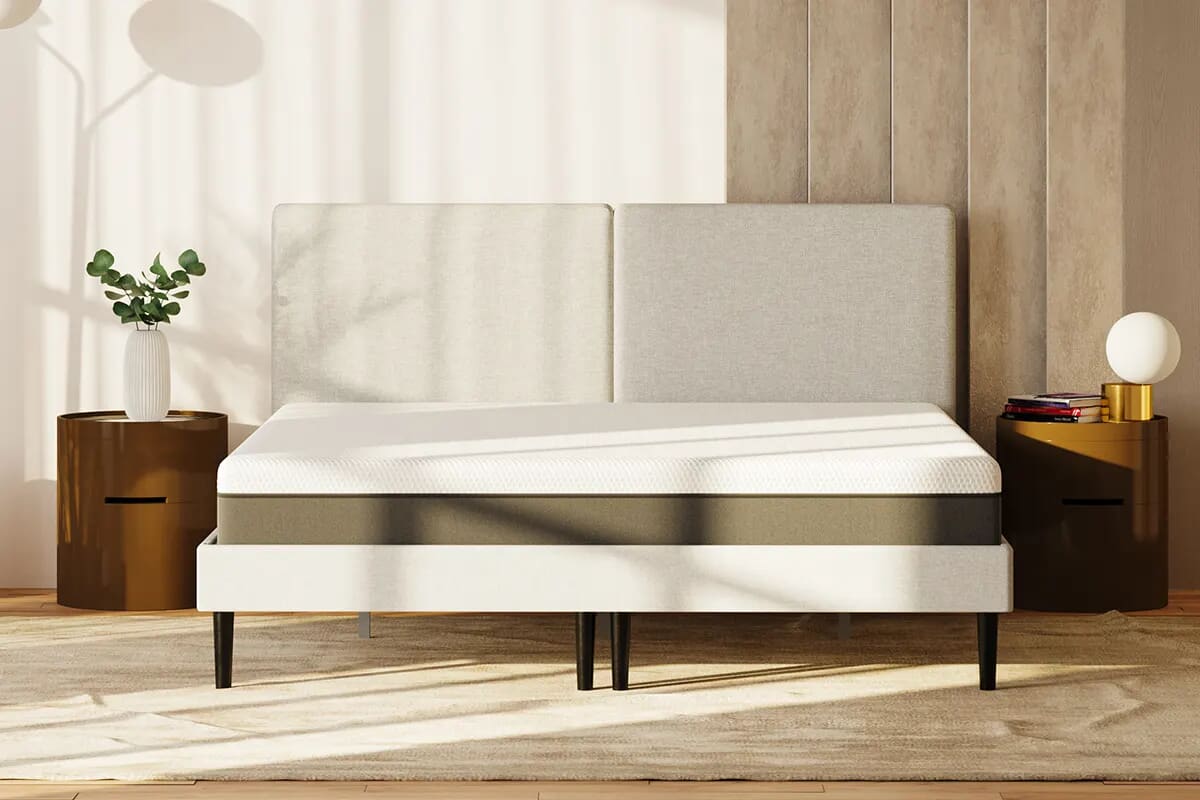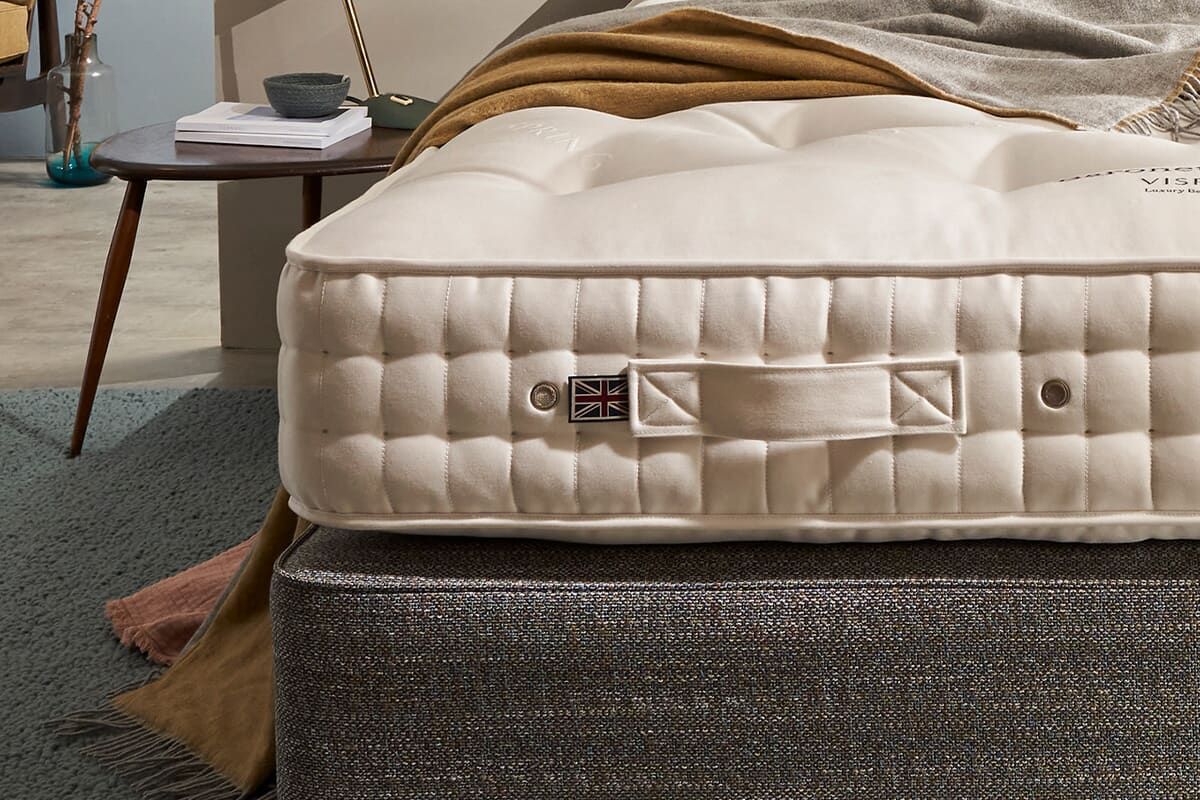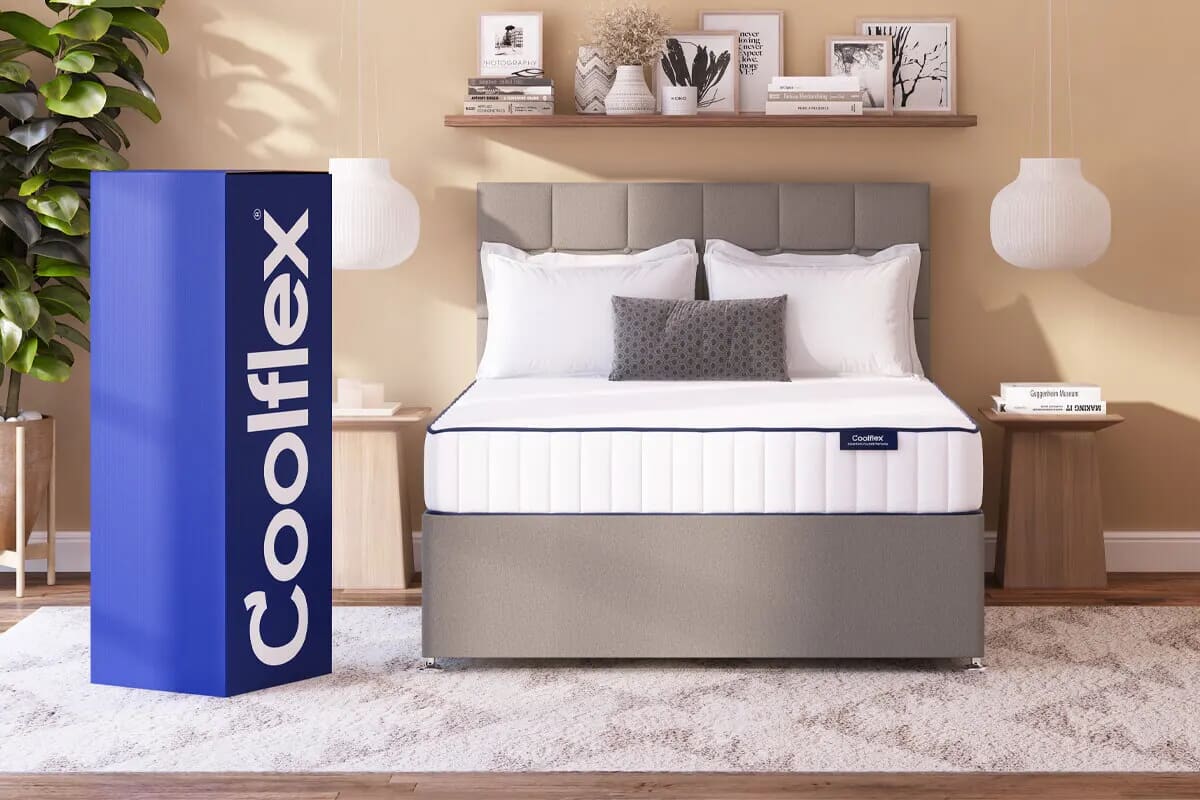Last updated: February 2025
What Is A Hybrid Mattress?
What exactly is a hybrid mattress? We reveal all, as well as their benefits.
We all want the best night’s sleep possible. A combination of comfort and support makes up the ‘golden ratio’ of mattresses. You love the snuggly, supportive softness of memory foam, but you want the firmness of a sprung mattress too. What’s the answer? It’s simple – the hybrid mattress.
In this guide, we’ll explore what makes a hybrid mattress so special, the benefits of a hybrid mattress, and everything else you’ll want to know if you’re interested in upgrading your current sleeping setup.
What does a hybrid mattress mean?
A hybrid mattress combines a variety of layers to give you the ultimate night’s sleep. Hybrids are a relatively modern invention - before someone had the good sense to combine memory foam and springs, you had an ‘either/or’ choice between two distinct types of mattresses.
Now, hybrid mattresses have become so popular that they make up the majority of online and in-store collections, simply because they really do give you the best of both worlds.
Also known as a ‘combination mattress’, a hybrid mattress is a multi-layered construction that has various layers of foam and comfort fibres on the top, with a pocketed sprung core. The actual construction will depend on the make and model, but the majority utilise memory foam as the upper layer to provide that cushioned comfort.
The benefits of a hybrid mattress
So why choose a hybrid mattress? Well, there are several benefits of a hybrid mattress thanks to its cleverly constructed designs that can help give you a better night’s sleep.
- They’re suitable for almost all types of sleepers – Hybrid mattresses are available in a range of different firmness ratings, ranging from super soft to extra firm. If you do want a softer feel, you can choose one with a pillow top. This selection of firmness ratings makes them suitable for front, back and side sleepers.
The memory foam layer is particularly good for side sleepers, as it keeps your neck, shoulders, lower back, and hips in alignment – commonly known as the ‘neutral position’. This provides you with a better, more restful night’s sleep as you are not constantly changing position to try and get comfortable. - They’re ideal for bad backs – A hybrid mattress is a great choice if you suffer from back pain. Don’t think that an orthopaedic mattress has to be rock-hard to do your back any good – a lot of people with back problems often find that a slightly softer mattress in the medium-firm to firm range is just as good if not better than an extra-firm mattress. The reason that hybrid mattresses are good for bad backs is that they combine a variety of different materials to deliver outstanding comfort and support, no matter how you like to sleep.
If you have a medical condition that affects your back, it’s best to talk to your GP or specialist before choosing a mattress. - They’re long-lasting – Hybrid mattresses are made to last a long time. If you rotate them regularly (or even flip and turn them if they’re double-sided), you should have excellent support and comfort for around 7-10 years, depending on the manufacturer’s recommendations. After that, you may find that the foam starts to take a little longer to bounce back.
If you want to extend the life of a hybrid mattress even more (and it doesn’t already have a pillow-top layer), buying a mattress topper may help to squeeze an extra year or two out of your mattress before it needs replacing. - Pure luxury and hotel-standard comfort – Ever wonder why most luxury hotels use hybrid mattresses? Because they know they deliver flawless comfort for the majority of sleepers. That top layer of memory foam contours to fit the shape of your body and can deliver an almost-weightless sensation so you can drift off into a peaceful sleep.
- Fewer lumps and bumps – Traditionally sprung mattresses, whether pocket spring or open coil, can get a little lumpy after a while as springs lose their bounce. A hybrid mattress protects you from that with multiple layers of foam so you never get into bed and feel a single spring poking you in the back!
- Cool gel layers keep you cooler – We’ve spoken briefly about the pros and cons of both pocket spring and memory foam mattresses, and one of the issues that some people encounter with memory foam is that it can feel a little warm. The dense foam traps the air, heating it and creating a warmer sleeping environment. Modern hybrid mattresses get around this problem by including a cool gel layer, which is foam that is treated with a special substance to keep the surrounding foam layers cooler.
Read our guide to The Best Hybrid Mattresses of 2024, including new Silentnight models, innovative sleep tech from Emma, and luxury hybrid mattresses from Tuft & Springs.
What’s in a hybrid mattress?
To give you a more in-depth idea of the construction of a hybrid mattress, let’s go through it layer by layer and find out what’s inside a hybrid mattress.
Pillow top
Not all hybrid mattresses have this feature, but if you love a softer feel, sleep on your back or just adore that snuggly feeling of sinking into a cloud-soft mattress at the end of the day, a pillow-top mattress is just the thing. The upper layer is a 1-2” (25-50mm) of comfort fibres, a little bit like an extra duvet or topper on top of your mattress.
The advantage of a pillow top design is that it gives you additional comfort. However, if you suffer from hot flushes or night sweats, pillow-top mattresses can feel a little warmer than ordinary hybrid mattresses.
Comfort layer
This is the layer that you lay on if you don’t have a pillow top mattress. This is usually made up of a layer of comfort foam such as memory foam or latex. You’ll get around 3-4” (75-100mm) of comfort foam, providing you with exceptional comfort.
The benefit of memory foam or latex is that it moulds to your body shape, cradling you and supporting you in a neutral position so that pressure points are eliminated. That cradling effect can ensure a more restful night’s sleep. The disadvantage of a memory foam layer is that once again, it tends to hold the heat so you may find it gets a little warm compared to an open-coil or pocketed sprung mattress. Latex or reflex hybrid mattresses, however, are much more breathable.
Support core
This is where you’ll find the sprung core. A matrix of individually pocketed springs makes up the centre, working both independently and in tandem with the surrounding springs to spread your and your partner’s weight. A sprung core distributes pressure and minimises movement transference. So, if you’re a ‘wriggler’ it should ensure that your night-time movements don’t wake up your partner or disturb their sleep.
Sprung cores also allow plenty of airflow, which can counteract the heating effect you get with memory foam, giving you a cooler, fresher night’s rest. The sprung core is the primary source of your support – the firmer the springs and the more springs in the core, the firmer the mattress rating. You’ll find that the core makes up the majority of a hybrid -mattress at around 7-8” (175-200mm) of depth.
Bottom layer
Most hybrid mattresses are single-sided. If you have a double-sided version, the layers will be repeated from the core back towards a top layer that can be slept on when you rotate and flip the mattress. However, in the majority of cases, a single-sided mattress will have a base layer that’s made from dense foam to provide you with additional padding and stability.



How long do hybrid mattresses last?
On average, hybrid mattresses last the same amount of time as a standard memory foam or pocket sprung mattress. You will need to bear in mind that most hybrid mattresses are single-sided. So, the best way to ensure your mattress lasts for as long as possible and remains comfortable with no dips or lumps is to rotate it every few months.
Turn your mattress from head to toe clockwise. Doing this allows the memory foam layers to relax and regain their original shape, preventing hollows from forming. Our guide to how often you should flip or turn your mattress will help.
Are hybrid mattresses better than memory foam mattresses?
The big advantage that hybrid mattresses have over memory foam options is that they are cooler. Because of the density of the foam used in a memory foam mattress, tiny pockets of air are trapped in the foam matrix. Your body heat warms up these air pockets, creating a warmer feeling. While some people find this comfortable, others may prefer a cooler sleeping environment. Our Memory Foam Buying Guide explains more about how memory foam works.
A hybrid mattress has a core made up of pocketed springs. This internal core has large corridors between each pocketed spring that allows the air to flow freely, often through side vents in the mattress’ outer shell. That airflow helps to cool the entire sleeping area down, creating a fresher feel.
The other plus-point that hybrids have is, again, related to that pocketed sprung core. The core layer provides more support that’s reactive to your movements and dissipates that movement throughout the matrix every time you shift position. If you’re sleeping with a partner, the minimal movement transference you get with a pocketed sprung core means you both get a great night’s sleep, no matter how much you wriggle!
Can a hybrid mattress come in a box?
Vacuum-packed and rolled mattresses have one big advantage – they’re much easier to transport and move around than traditional mattresses. Most modern hybrid mattresses come boxed and rolled, making them simple to get up a narrow set of stairs and along that hallway to your bedroom. Once there, all you need to do is unbox and unroll the mattress and leave it for a while to regain it's shape. It should be ready to sleep on after 24 hours, but can take a couple of weeks to reach its full capacity.
There are some pretty convincing arguments in favour of the hybrid mattress being the best choice for just about everyone. They’ve got the benefits of a pocket spring core, but the snuggly comfort of memory foam. They’re suitable for all types of sleepers and offer great support if you suffer from a bad back. But if you want to know more, we’ve got plenty of advice for you - check out our break down of Pocket-sprung Vs Memory Foam Vs Hybrid: Which Mattress Is Best? or our Mattress Buying Guide for more information on the other types of mattress out there.




